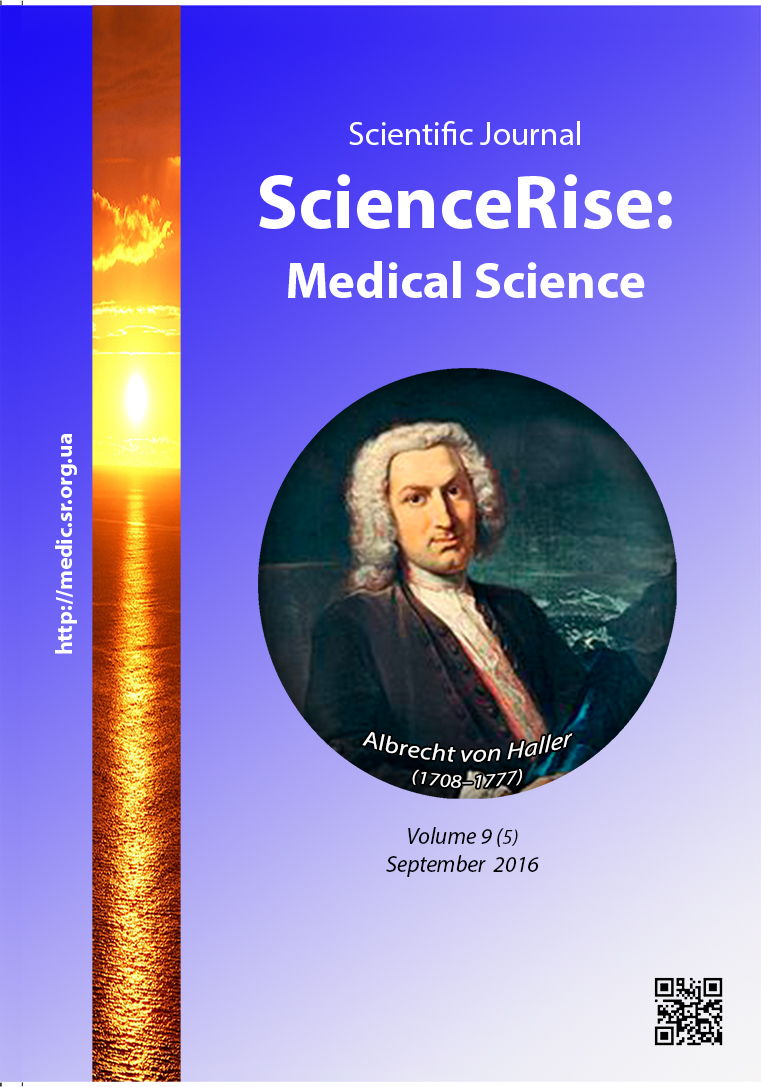Current approaches to the therapy of vulvovaginites taking into account antibiotic resistance to the infectious agents
DOI:
https://doi.org/10.15587/2519-4798.2016.77255Keywords:
nonspecific vulvovaginitis, microbiocenosis, conventionally pathogenic microflora, sensitivity to antibacterial preparationsAbstract
Aim of research: the study of qualitative composition and parameters of sensitivity/resistance to antibiotics of the different groups of biota of the low parts of genital tract in patients with nonspecific vulvovaginites.
Methods of research: 242 women 18-47 years old underwent clinical-laboratory examination on the base of clinic and department of sexually transmitted infections SI “Institute of dermatology and venereology, NAMS of Ukraine”. They were divided in two groups: 1st group – 205 (84,7 %) patients with clinical and laboratory signs of vulvovaginitis; 2th group (control one) -– 37 (15,3 %) clinically healthy women. All patients, included in the research, underwent the complex of laboratory examinations according to the regulative documents of HM of Ukraine.
Results of research: The composition of vaginal microbiocenosis in patients with vulgovaginites, caused by conventionally pathogenic microorganisms was characterized with the prevalence of aerobic representatives of Enterobacteriaceae and Staphylococcaceae families that formed association both between themselves and with representatives of the other taxonomic groups. The therapy of vulvovaginites, caused by aerobic conventionally pathogenic microorganisms, must be realized individually, taking into account the results of determination of sensitivity of the aerobic microflora. At impossibility of cultural study with determination of sensitivity of separated microorganisms to antibacterial remedies, the preparations of choice in the treatment of vulvovaginites, caused with conventionally pathogenic microorganisms can be quinolones, lincosamides, nitrofurans and ceftriaxone that the higher sensitivity of conventionally pathogenic microorganisms was observed to
References
- Rachmatulina, M. R., Shatalova, A. Yu. (2009). Sovremennye predstavleniya o microbiotchenoze vaginalnogo biotope u zhenshchin [Modern ideas on vaginal biotope normocenosis and its disorders diagnosed in reproductive women (literature review)]. Vestnik dermatologii i venerologii, 3, 38–42.
- Razzak, M., Al-Charrakh, A., AL-Greitty, B. (2011). Relationship between lactobacilli and opportunistic bacterial pathogens associated with vaginitis. North American Journal of Medical Sciences, 185–192. doi: 10.4297/najms.2011.3185
- Goncharenko, V. V., Dzhoraeva, S. K., Shchegolyeva, O. V., Nikitenko, I. N., Bezruchenko, A. A. (2014). Microbiologichnyu monitoring infekchiy urogenitalnogo tractu v umovach venerologichnoi kliniku [Microbiological monitoring of infection in venerological clinic]. Dermatologiya ta venerologiya, 4 (66), 44–53.
- Wang, Z., Fu, L., Xiong, Z., Qin, Q., Yu, T., Wu, Y. et. al. (2016). Diagnosis and microecological characteristics of aerobic vaginitis in outpatients based on preformed enzymes. Taiwanese Journal of Obstetrics and Gynecology, 55 (1), 40–44. doi: 10.1016/j.tjog.2015.06.012
- Borovkova, L. V., Chelnokova, E. V. (2010). Sovremennye metodu diagnostiki i lecheniya infekchiy, peredaushchikhsya polovum putem [The contemporary methods of diagnostics and treating of the sexually transmitted diseases]. Meditchinskiy almanah, 2 (11), 150–156.
- Rachmatulina, M. R. (2013). Sovremennye podchodu k terapii vulvovaginitov, vuzvannich uslovno-patogennumi mikroorganizmami s uchetom antibakterialnoy rezistentnosti infektchionnuh agentov [Current approaches to the treatment of vulvovaginitis caused by opportunistic microorganisms taking into consideration the antibacterial resistance of infectious agents]. Vestnik dermatologii i venerologii, 2, 44–52.
- Ershov, G. V., Bochkarev, D. N., Smolenov, I. V. (2004). Etiologicheskaya strultura i rezistentnost vozbuditeley zabolevaniy organov malogo taza u zhenshchin [Etiological structure and antimicrobical resistance of pathogens isolated from women with pelvic inflammatory deaseases]. KMACh, 6 (2), 193–200.
- Shatalova, A. Yu., Rachmatulina, M. R., Plachova, K. I. (2012). Analiz faktorov riska i kliniko-laboratornih osobennostey vospalitelnuh zabolevaniy mochepolovogo trakta u zhenshchin reproduktivnogo vozrasta [Analysis of risk factors and clinical and laboratory characteristics of inflammatory diseases of the urogenital tract in women of reproductive age]. Vestnik dermatologii i venerologii, 1, 43–48.
- Johnson, L., Sabel, A., Burman, W. J., Everhart, R. M., Rome, M., MacKenzie, T. D. et. al. (2008). Emergence of Fluoroquinolone Resistance in Outpatient Urinary Escherichia coli Isolates. The American Journal of Medicine, 121 (10), 876–884. doi: 10.1016/j.amjmed.2008.04.039
- Kahlmeter, G. (2002). An international survey of the antimicrobial susceptibility of pathogens from uncomplicated urinary tract infections: the ECOmiddle dotSENS Project. Journal of Antimicrobial Chemotherapy, 51 (1), 69–76. doi: 10.1093/jac/dkg028
- Nakaz “Pro zatverdzhennya metodychnyh vkazivok “Vyznachennya chutlyvosti mikroorganizmiv do antymikrobnyh preparativ” [Determination of microorganism sensitivity to antibiotic treatment] (2007). Ministerstvo Ohorony Zdorov'ja Ukrai'ny, 167.
- Kuzmenko, A. N. (2015). Osobennosti biotu urugenitalnogo trakta u zhenshchin reproduktivnogo vozrasta s nespetscificheskimi vulvovaginitami [Urogenital tract biota particularity of reproductive women with unspecific vulvovaginite]. Vestnik dermatologii i venerologii, 3 (69), 36–43.
Downloads
Published
How to Cite
Issue
Section
License
Copyright (c) 2016 Глеб Михайлович Бондаренко, Светлана Карьягдыевна Джораева, Анна Константиновна Кондакова, Ольга Анатольевна Лященко, Юлия Валерьевна Щербакова, Наталия Владимировна Соболь

This work is licensed under a Creative Commons Attribution 4.0 International License.
Our journal abides by the Creative Commons CC BY copyright rights and permissions for open access journals.
Authors, who are published in this journal, agree to the following conditions:
1. The authors reserve the right to authorship of the work and pass the first publication right of this work to the journal under the terms of a Creative Commons CC BY, which allows others to freely distribute the published research with the obligatory reference to the authors of the original work and the first publication of the work in this journal.
2. The authors have the right to conclude separate supplement agreements that relate to non-exclusive work distribution in the form in which it has been published by the journal (for example, to upload the work to the online storage of the journal or publish it as part of a monograph), provided that the reference to the first publication of the work in this journal is included.









